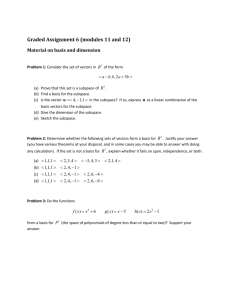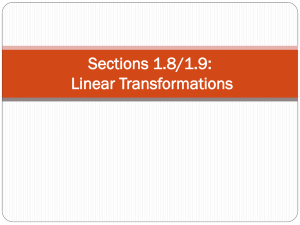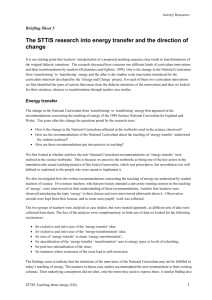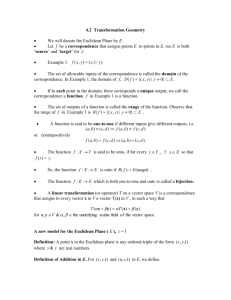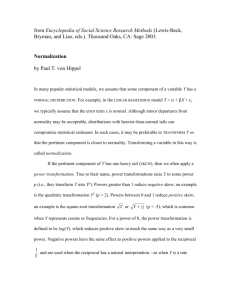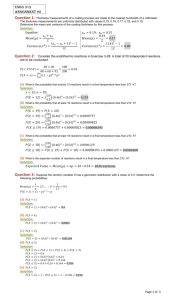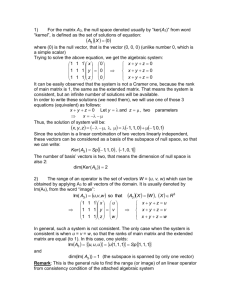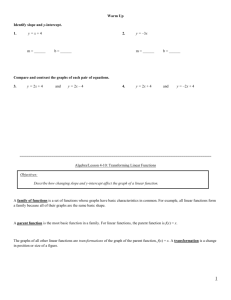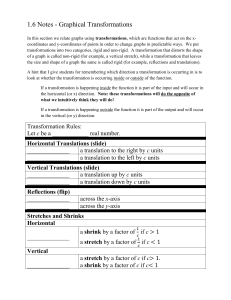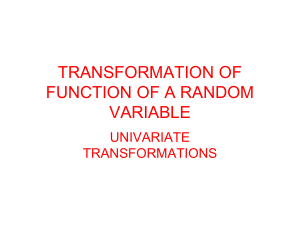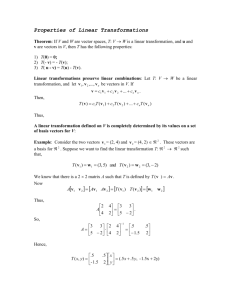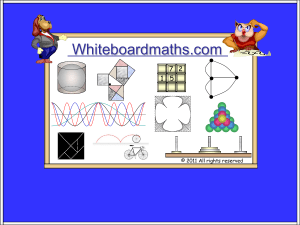Document
advertisement
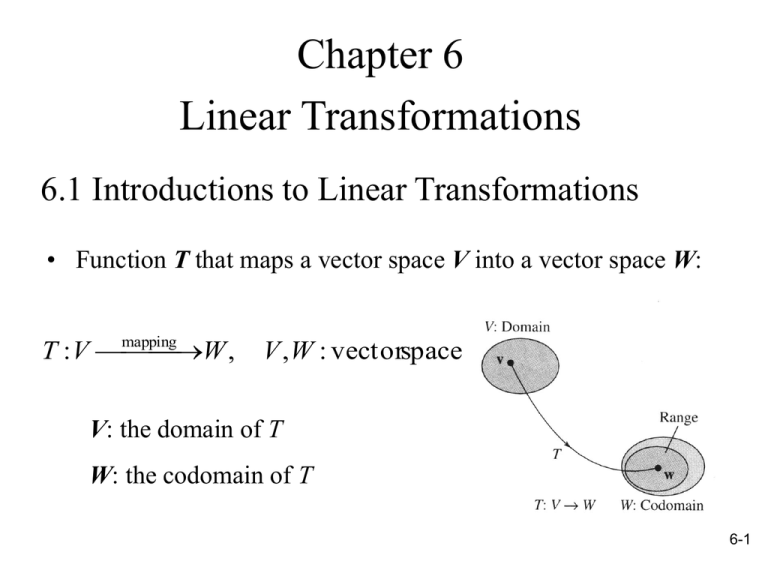
Chapter 6
Linear Transformations
6.1 Introductions to Linear Transformations
• Function T that maps a vector space V into a vector space W:
T : V mapping
W ,
V ,W : vectorspace
V: the domain of T
W: the codomain of T
6-1
• Image of v under T:
If v is in V and w is in W such that
T ( v) w
Then w is called the image of v under T .
• the range of T:
The set of all images of vectors in V.
• the preimage of w:
The set of all v in V such that T(v)=w.
6-2
• Notes:
(1) A linear transformation is said to be operation preserving, because
the same result occurs whether the operations of addition and
scalar multiplication are performed before or after T.
T (u v) T (u) T ( v)
Addition
in V
Addition
in W
T (cu) cT (u)
Scalar
multiplication
in V
Scalar
multiplication
in W
(2) A linear transformation T : V V from a vector space into
itself is called a linear operator.
6-3
6-4
• Two simple linear transformations:
Zero transformation:
T :V W
T ( v) 0, v V
Identity transformation:
T :V V
T ( v) v, v V
6-5
6-6
6-7
6.2 The Kernel and Range a Linear
Transformation
6-8
6-9
• Note:
The kernel of T is sometimes called the nullspace of T.
6-10
T (x) Ax (a linear tr ansformati on T : R n R m )
Ker (T ) NS ( A) x | Ax 0, x R m (subspace of R m )
• Range of a linear transformation T:
Let T : V W be a L.T .
T hen theset of all vectorsw in W thatare images of vectors
in V is called therange of T and is denotedby range(T )
range(T ) {T ( v) | v V }
6-11
• Notes:
T : V W is a L.T.
(1) Ker(T ) is subspace of V
(2)range(T ) is subspace of W
6-12
• Note:
Let T : R n R m be theL.T .given by T (x) Ax, then
rank(T ) rank( A)
nullity(T ) nullity( A)
6-13
6-14
• One-to-one:
A functionT : V W is called one- to - oneif thepreimageof
everyw in therange consistsof a single vector.
T is one- to - oneiff for all u and v inV, T (u) T ( v)
implies thatu v.
one-to-one
not one-to-one
• Onto:
A functionT : V W is said to be ontoif everyelement
in w has a preimagein V
(T is onto W when W is equal to the range of T.)
6-15
6-16
6-17
6-18
6.3 Matrices for Liner Transformations
• Two representations of the linear transformation T:R3→R3 :
(1)T ( x1, x2 , x3 ) (2x1 x2 x3 , x1 3x2 2x3 ,3x2 4x3 )
2 1 1 x1
(2)T (x) Ax 1 3 2 x2
0
3
4
x3
• Three reasons for matrix representation of a linear
transformation:
– It is simpler to write.
– It is simpler to read.
– It is more easily adapted for computer use.
6-19
6-20
• Notes:
(1) The standard matrix for the zero transformation from Rn into Rm
is the mn zero matrix.
(2) The standard matrix for the identity transformation from Rn into
Rn is the nn identity matrix In
• Composition of T1:Rn→Rm with
T2:Rm→Rp :
T ( v) T2 (T1 ( v)), v Rn
T T2 T1
domain of T domain of T1
6-21
• Note:
T1 T2 T2 T1
6-22
• Note: If the transformation T is invertible, then the inverse
is unique and denoted by T–1 .
6-23
6-24
6-25
6.4 Transition Matrices and Similarty
T :V V
( a L.T ).
B {v1 , v2 ,, vn } ( a basis of V ), B' {w1 , w2 ,, wn } (a basis of V )
A T (v1 )B , T (v2 )B ,, T (vn )B
A' T (w1 )B' , T (w2 )B' ,, T (wn )B'
P w1 B , w2 B ,, wn B
P1 v1 B' , v2 B' ,, vn B'
( matrixof T relativeto B)
(matrixof T relativeto B' )
( transition matrixfromB' to B )
( transition matrixfromB to B' )
v B Pv B ' ,
vB ' P 1vB
T ( v)B AvB
T ( v)B' A' vB'
6-26
• Two ways to get from
vB' to T (v) :
B'
indirect
(1)(direct)
A'[ v]B ' [T ( v)]B '
(2)(indirect)
P 1 AP[ v]B ' [T ( v)]B '
A' P 1 AP
direct
6-27
6-28
• Note: From the definition of similarity it follows that any tow
matrices that represent the same linear transformation
T : V V with respect to different based must be similar.
6-29
6.5 Applications of Linear Transformations
6-30
6-31
6-32
6-33
6-34


